INSTRUCTIONS TO CANDIDATES
- Write your name, school and index number in the spaces provided above.
- Write the date of examination and sign in the spaces provided above.
- Answer ALL the questions in section A by filling in the spaces provided.
- In section B, answer question 6 (compulsory question) and any other one question from the remaining two questions. (i.e. 7 or 8)
- Candidates may be penalized even wrong spellings of technical terms.
- Candidates should check to ensure that all pages are printed as indicated and no questions are missing.
FOR OFFICIAL USE ONLY
|
Questions |
Maximum score |
Candidate’s score |
|
|
Section A |
1 |
8 |
|
|
2 |
8 |
||
|
3 |
8 |
||
|
4 |
8 |
||
|
5 |
8 |
||
|
Section B |
6 |
20 |
|
|
7 |
20 |
||
|
8 |
20 |
||
|
Total Score |
80 |

QUESTIONS & MARKING SCHEME
- The diagram below shows a pictomicrogram of an animal cell. Study it and answer the questions that follow.
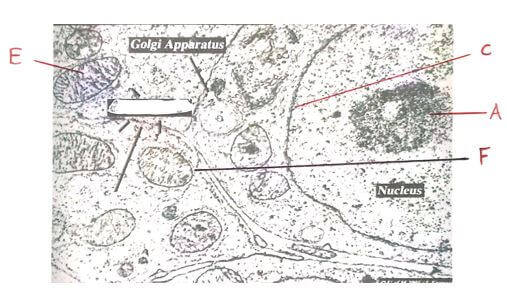
- Identify the structures labeled A and C (2 marks)
- A Nucleolus;
- C Nuclear membrane;
-
- Identify the organelle labeled E (1 mark)
- Mitochondrion; rej. Mitochondria
- State the adaptations of the structure identified in b (i) above (2 marks)
- The inner membrane is highly folded into cristae to increase the surface area for attachment of respiratory enzymes;
- The matrix is a fluid medium containing respiratory enzymes/site for respiratory reactions;
- Identify the organelle labeled E (1 mark)
- Using a ruler, measure of the longest side of organelle labeled F, Hence calculate the actual length of the structure if the magnification used is X4000. (3 marks)
- Light of cell =1.7 cm magnification=Drawing length;
Actual length
1mm=1000um Actual length=Drawing length =17000 =42.5um;
17mm= X magnification 4000
17000um;
- Light of cell =1.7 cm magnification=Drawing length;
- Identify the structures labeled A and C (2 marks)
- An experiment was set up as shown below. Study the diagram and answer the questions that follow.
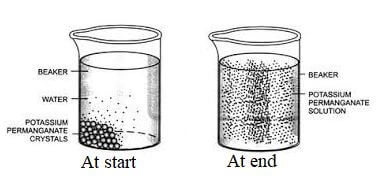
- Name the physiological process being investigated. (1 mark)
- Diffusion
- Account for the observation at the end of the experiment (3 marks)
- The purple colour of potassium permanganate solution had spread evenly throughout the water in the beaker; due to the random motion/movement of Potassium manganate (VII) molecules; which causes them to move from a region of high concentration to a region of low concentration.
- Account for the observation made if hot water was used at the start of the experiment. (2 mark)
- Hot water causes an increase in kinetic energy of molecules; this causes faster spread of purple colour to the areas of low concentration.
- Name the property of the cell membrane that enables it detect changes in the environment ( 1 mark)
- It has electric charges
- How is the process named in a above important in predation
- It enables the prey detect presence of predators through smell/ Enables predators to detect presence of prey through smell
- Name the physiological process being investigated. (1 mark)
- The graph below shows the growth pattern of an organism.
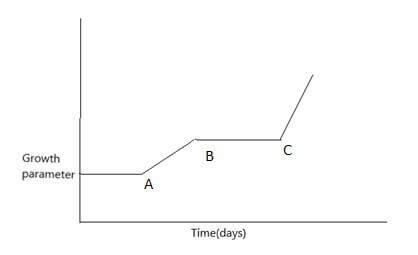
- Name the type of growth curve shown above. (1mrk)
- Discontinuous/intermittent curve
- Name the phylum where organisms shows the above curve (1mrk)
- Arthropoda
- Name the hormones that influences the growth above. (2mks)
- Juvenile hormone
- Ecdysone hormone
- Give reasons for the shape of the graph between:
- A and B ( 2mks)
- Rapid growth due to the shedding off the hard exoskeleton initiated by secretion of ecdysone hormone
- B and C (2mks)
- Constant growth due to hardening of the exoskeleton initiated by juvenile hormone.
- A and B ( 2mks)
- Name the type of growth curve shown above. (1mrk)
-
- Mrs Akili is blood group B and her husband is of blood group A. They had two daughters and two sons .one of the sons is blood group O.
- What were the parental genotypes? (1 mark)
- Father - AO; Mother – BO ;
- Illustrate the above using a genetic cross. (3 marks)
- Parental genotype AO X BO ;
- Gamates A O B O ;
- Fusion
- F1 genotypes AB AO BO OO ;
- What were the parental genotypes? (1 mark)
- In a class of 50 pupils, the heights were distributed as follows:
Height in cm
130
133
136
139
142
145
148
151
154
157
160
Number of students
1
3
5
6
8
9
7
5
4
2
0
- Identify the type of variation illustrated in the above table. (1 mark)
- Continuous;
- Predict the type of curve produced if the number of students is plotted against height. (1 mark)
- Normal distribution;
- Other than genes, name one other factor that influences the expression of characteristics exhibiting the variation named in (i) above. (1 mark)
- Environmental conditions / Environment;
- Give one other characteristic in animals which show the same kind of variation as height. (1 mark)
- Weight, coat or skin colour;
- Identify the type of variation illustrated in the above table. (1 mark)
- Mrs Akili is blood group B and her husband is of blood group A. They had two daughters and two sons .one of the sons is blood group O.
- Below is a diagram showing part of human digestive system.
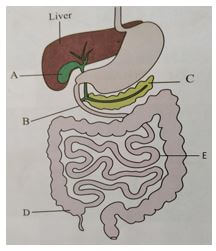
- Name the parts labelled B and C. (2mks)
- B Duodenum;
- C Pancreas;
-
- Name the substance produced by the part labelled A. (1mk)
- Bile;
- State the functions of the substance named in b(i) above. (1mk)
- Emulsifies fat;
- Neutralizes acidic chyme;
- Name the substance produced by the part labelled A. (1mk)
- What is the functional relationship between the part labelled A and the liver (1mk)
- The liver synthesizes bile which is stored in organ A;
- Give any three adaptations of part labelled E to its functions (3mks)
- Long to provide a large surface area for absorption of digested food;
- Narrow to bring digested food into close contact with the walls of the ileum for easier absorption;
- Highly coiled in order to slow down movement of food and thus allowing more time for digestion and absorption to take place;
- Large number of villi and microvilli which increases the surface area for absorption of end products of digestion;
- Presence of thin layer of cells through which digested food diffuses;
- Presence of dense network of blood capillarie in the villi into which amino acids, sugars, vitamins, mineral salts are absorbed;
- Presence of lacteals in the villi for the absorption of fatty acids and glycerol;
- Name the parts labelled B and C. (2mks)
- The table below shows the relative population of two herbivores M (capra aegagrus hircus and N (Ovis aries) in a small game reserve in Sokoke forest. The herbivores are closely related and have nearly overlapping niches. Over the study period, a predatory species to the herbivores was introduced into the reserve.
Time (month)
0
2
4
6
8
10
12
14
Population of M
64
64
70
72
120
130
132
134
Population of N
50
54
60
78
59
40
30
22
- On the grid provided below, plot the graph of population of M (capra aegagrus hircus and N (Ovis aries) against time on the same axes. (8 marks)
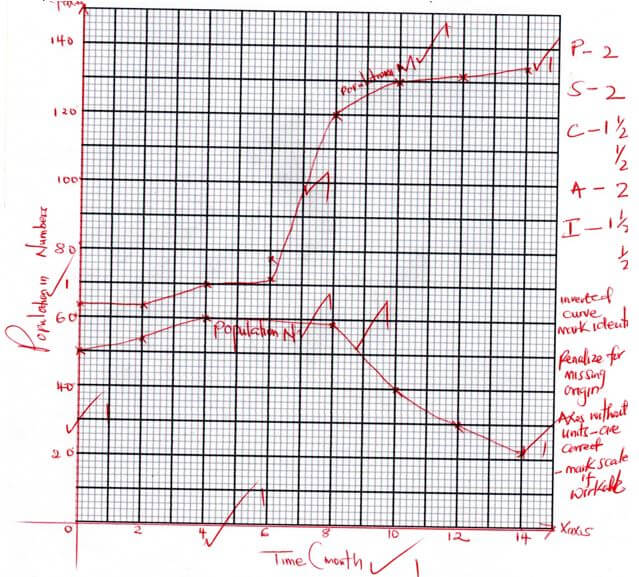
- At what time was the predatory species most likely introduced? (1 mark)
- 6 month
- Account for the shape of the graphs between:
- 6th – 8th month of species capra aegagrus hircus (M) (2 marks)
- The population of M rises rapidly; due to reduced competition by species N; accepts species M has an adaptive advantage over species N
- 6th – 10th month of species ovis aries (N). (2 marks)
- The population of N declines gradually; due to predation; accepts N has less adaptive advantage over M
- 6th – 8th month of species capra aegagrus hircus (M) (2 marks)
- State one predatory characteristics of the predator introduced in the ecosystem that enabled it to locate the prey. (1 mark)
- Acute sense of smell and sight; powerful limb muscle for agility; camouflage;
- Name the methods that could have been used to estimate the population of M.(1 mark)
- Direct counting
- Zebras and gazelles can occupy the same ecological habitat without depleting the available resources. Explain. (2 marks)
- Zebras are mainly grazers; while gazelles are browsers; they occupy different ecological niches
- Name three human activities that can affect the population of organisms in the game reserve (3 marks)
- Forest fires
- Deforestation
- Mining
- Farming
- Poaching
- On the grid provided below, plot the graph of population of M (capra aegagrus hircus and N (Ovis aries) against time on the same axes. (8 marks)
-
- Discuss how xerophytes are structurally adapted to their habitat. (12 marks)
- Describe five factors affecting breathing rate in humans (8 marks)
-
- Describe how the following supports the theory of evolution
- Comparative anatomy (6mrks)
- Geographical distribution of organisms (4mrks)
- How is the proximal convoluted tubule adapted to it’s function (10mrks)
- Describe how the following supports the theory of evolution
-
-
- In some leaves are reduced in size or are modified to spines to reduce surface area over which transpiration occurs;
- Some shed their leaves during draught to reduce surface area exposed to transpiration;
- Some have thick waxy cuticle to minimise the rate of cuticular transpiration;
- Some leaves are folded to reduce rate of transpiration by not exposing stomata to environmental factors;
- Some have sunken stomata which accumulate moisture in substomatal air spaces leading to low diffusion gradient;
- Most show reduced number of stomata that lowers the rate of transpiration;
- Some experience reduced stomatal rhythm to prevent excessive loss of water by transpiration;
- Some plants have deep roots to absorp water from deep in the soil;
- Other plants have superficial roots which grow horizontally close to the soil surface to absorb water after after a short or light shower of rain;
- Some plants store water in parenchyma cells found in succulent stems;
- Age; young people breath faster than the old because they have a higher demand for oxygen;
- Temperature; in higher temperature, the breathing rate increases but in too high temperature the rate increases;
- Health; increase of fever increases metabolism hence high breathing rate;
- Exercise; during vigorous exercise the rate of breathing increases to supply more oxygen to meet the demand and also remove the extra CO2 produced during respiration;
- Altitude; at high altitude, Oxygen concentration is low thus faster rate of breathing to supply tissues with sufficient Oxygen;
- Emotions; affect production of hormone adrenaline which increases metabolism hence more rate of breathing e.g in anxiety, fright;
-
-
-
- comparative anatomy Based on the comparison of different structures; Homologous structures; are those having a common ancestral or embryological origin but perform different functions; e.g. pentadactyl limb plan of vertebrates; (which has evolved in class mammalian into using for flying in bats, long fast running legs in horse and flipper for swimming in whales) divergent evolution;
Analogous structures having different ancestral/embryological origin but have evolved to perform similar functions; (due to exploitation of similar ecological habitats) e.g. wings of insects; - Convergent evolutions; (4mks) - Geographical distribution
- Based on the theory that before the continental drift; there was a single land mass/pangea; with continental drift, members of the population of originally the same species became separated and isolated; by (geographical barriers such as seas/oceans).
- They separated into different continents. The result of the isolation was evolution of different species; examples are members of the cat family in different continents such as the panthers and jaguars in South American Amazon Forest; (Leopards and Cheetahs in African Congo Forest, Tigers in Asian Forests)
- comparative anatomy Based on the comparison of different structures; Homologous structures; are those having a common ancestral or embryological origin but perform different functions; e.g. pentadactyl limb plan of vertebrates; (which has evolved in class mammalian into using for flying in bats, long fast running legs in horse and flipper for swimming in whales) divergent evolution;
- Long to provide large surface area for efficient selective re-absorption;
- It is coiled to reduce the speed of the flow of the filtrate to provide more time for maximum re- absorption;
- Cells lining the tubules have numerous mitochondria which provide ATP energy that is used in the selective reabsorption since it is an active process;
- The cells of the tubule have micro villi which increases the surface area for faster rate of reabsorption;
- The tubule is highly vascularized for faster reabsorption and transportation of reabsorbed substance;
-
Download Biology Paper 2 Questions and Answers - Kassu Jet Pre Mocks 2022.
Tap Here to Download for 50/-
Get on WhatsApp for 50/-
Why download?
- ✔ To read offline at any time.
- ✔ To Print at your convenience
- ✔ Share Easily with Friends / Students

